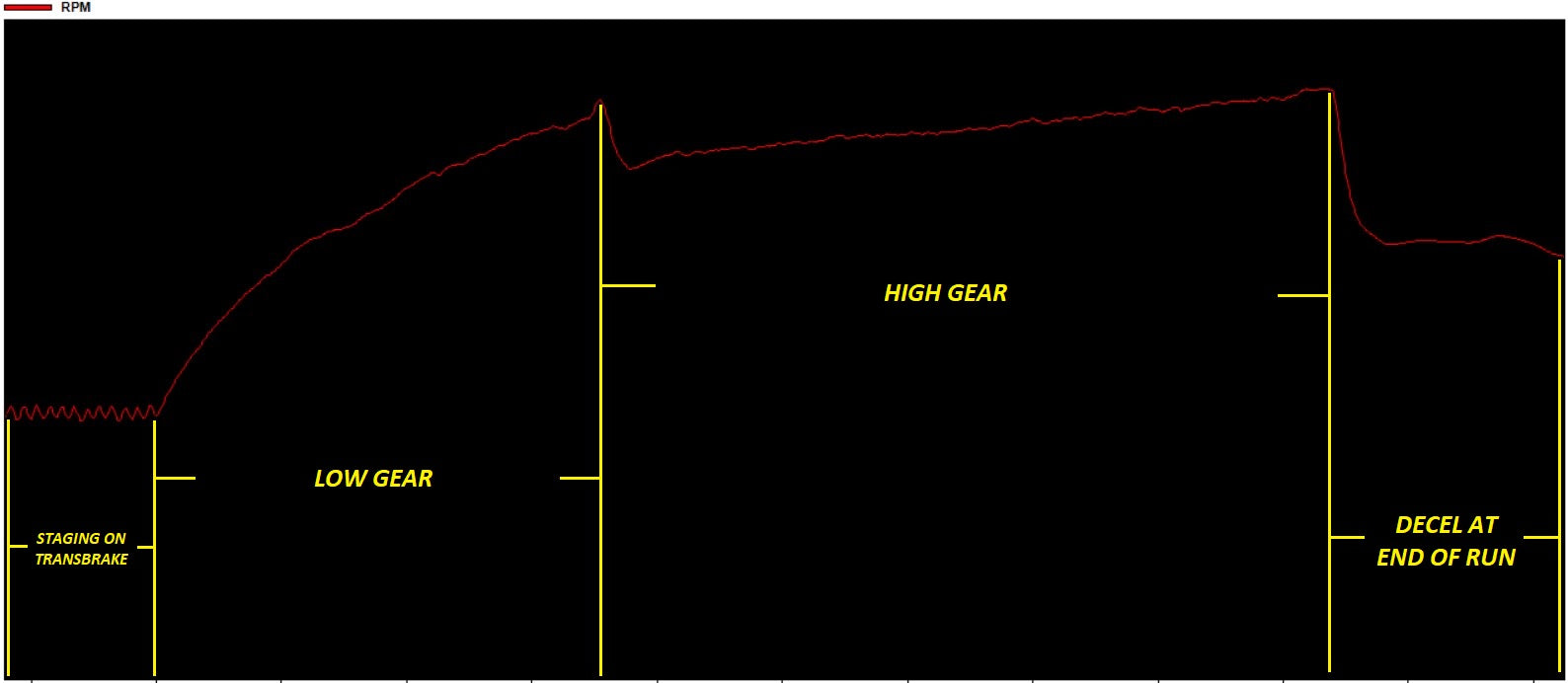Check Order Status

Data Interpretation
Today we're going to touch base on a little bit of data interpretation as it applies to heads-up & fast index drag racing applications. Specifically on this post we'll be focusing on engine acceleration in low gear.
The two engine RPM graphs pictured here represent two different cars equipped with two different torque converters; both running on prepped racing surfaces, both on 275 Pro Radial tires, & both with no wheel speed issues during the passes represented by each graph.
In the first graph you can observe a loss of engine acceleration in low gear after the initial flash event of the converter as the vehicle is accelerating away from the starting line, then engine acceleration recovers & climbs to the shift point.
In the second graph you can observe a clean, smooth engine acceleration event in low gear with no loss of engine acceleration throughout the duration of low gear from launch to shift point.
The first graph represents a vehicle with one of several possibilities that could be causing the loss of engine acceleration:
1.) A mismatch of components with respect to the complete powertrain combination.
2.) A tuning issue in the engine management system, converter charge oil circuitry, and/or chassis.
3.) A torque converter build (with respect to core selection, stator design, stator cap design, & internal clearances) that inherently decelerates an engine after the flash event.
The second graph represents what we feel is generally an ideally matched combination of parts, tuning, & converter build type/component design.
Going back to the first graph; regardless of the cause of the engine deceleration event in this graph the effect is an imbalance between the pump torque drive requirement of the torque converter & the input torque from the crankshaft to the torque converter. Essentially, the combination of load behind the torque converter & the pump torque drive requirement of the converter exceeds the torque output of the engine in that specific range of RPM where engine deceleration is occurring. As a result, overall vehicle acceleration suffers in this area of the engine acceleration curve. This is why it is always beneficial & recommended to data log acceleration G force data. Overlapping G meter to engine acceleration will help reveal areas where improvements may be made to help maximize G force not only in terms of peak G force, but in duration of G force. The longer the G force curve can be stretched out as it naturally drops with vehicle acceleration will ultimately result in lower E.T.'s. Paying attention to the G force curve after peak instead of simply focusing on only a high initial peak G force reading is one of the keys to a successful, winning drag racing program.
The engine line in graph 2 represents a pass that will typically feature high, consistent G force readings with less overall drop in the G force curve throughout the duration of the run thanks to more of the engine torque production & converter coupling / drive characteristics being successfully used to accelerate the vehicle. Graph 1 reveals engine torque production being delayed in useful acceleration until the converter reaches a balance between speed ratio & K factor at which point the converter will then allow the engine to begin accelerating efficiently again.
In sharing this information our goal is to educate as to the utmost importance of using properly matched components throughout the entire vehicle as well as employing proper, thorough tuning throughout the entire vehicle when seeking to maximize overall performance potential, as well as to reveal how data logging can highlight inefficiencies, mismatches, & issues in a combination particularly with respect to torque converter function.
When it comes to automatic transmission-equipped drag racing vehicles, the torque converter is the most important part of whole combination. Converter design & function will make or break a combination. Quality data is your friend, & G meter wins races.

